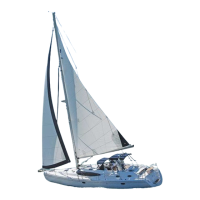nt
r
• Gettin
Underwa
1
.
full
ad
ustin
some tension on the sheet to keep the sail
tau
t
2. Install the out haul line in the boom with the messen
er
line
rovided and lead from the sheave at the back of the
boom throu
h the lower crin
le at the back o
the sail and
a
t to the end o
the castin
.
. Install ree
in
lines in the boom with the messen
er
line provided and lead
rom the sheave throu
h the rel-
vant crin
le at the back of the sail and then down to the
slidin
e
e on the bottom o
the boom. Pull enou
h slack
into the ree
line so that the sail can be
ull
raised unim-
peded b
the reef lines. Tie the mainsail onto the boom
with the sail ties provided
.
nsta
t
e
s
eet onto t
e
an
ea
t
e s
eets
inside the shrouds to the lead blocks on the cabin top and
a
t to the
ams or winches on the house top. Tie
i
ure
i
ht knots in the end of the sheets to prevent them from
runnin
back throu
h the
ams.
. Raise and unfurl sails, be
innin
with the main and
then the
ib while powerin
into the wind.
nce each
hal
ard, is tensioned b
the winch, the hal
ard can be
us
e
own
nto
ts res
ect
ve ro
e c
utc
es an
t
e
hal
ard removed
rom the winch,
reein
the winch
or the
next hal
ard or sheet. However, care should be taken not
to
na
vertent
open t
e rope c
utc
es, s
nce t
e sa
s
will lower rapidl
i
this is done. When the sails are raised,
the boat can be laid o
and the en
ine turned o
.
nce the main is sheeted in and
ou are sailin
upwind, con
irm the main toppin
li
t position. The main
should be capable of sheetin
in hard without the toppin
li
t bein
ti
ht. With the main sheeted in hard, the toppin
li
t should have ei
ht to ten inches o
sa
and should be
a
uste
accor
n
7. A
ter a da
o
sailin
, the sails should be lowered
furled in while a
ain powerin
into the wind, with the
ib
urled in
irst and then b
lowerin
the main. Protect
our
sails b
coverin
them with the laz
ack sailcover or
url-
n
t
em comp
ete
up.
3.3.2 Tunin
the B&R Ri
The easiest method
or tunin
the B
R ri
is to per
orm
step one as
ollows be
ore the mast is stepped, with it
l
in
aft side down on two sawhorses. Be
in with all ri
-
in
slack. I
the mast is alread
stepped, loosen all the
ri
in
, and then proceed to step one
1. Start with all the ri
in
slack. Then induce the mast
bend b
ti
htenin
the reverse dia
onals
diamonds
.
easure t
e
an
tens
on
n
a
ne or t
e ma
n
a
-
ard between the masthead and the
ooseneck. The
maximum amount o
bend should be no more than 1
f the len
th of “P” for the standard ri
and no more than
2”
50mm
or the
urlin
mast. Measured perpendicular
rom the a
t
ace o
the mast to the hal
ard at the deepest
art of the bend. It can be less than that based on the sail
shape and
our own pre
erence. The bend should also
be evenl
distributed alon
the mast to
ive a smooth
shape. Keep in mind that bendin
a furlin
mast ma
m
k
it m
r
i
i
lt t
rl
n
will n
t
m
h t
l
t-
ten the sail as in a standard ri
. It is ver
important that
the mast also be strai
ht from side to side at this time.
Ti
hten or loosen the reverse dia
onals to achieve this.
2. Ste
the mast with all shrouds attached but with the
turnbuckles completel
loosened
i
the mast was not
alread
stepped
.
. Attach the
ib hal
ard to a cleat on the bow to support
the mast in a raked position
the masthead should be
about 2’-0”
60cm
behind the step
. Attach the verticals
and ti
hten them until
ou can
ust see the hole
or the
otter pin in the turnbuckle. Ti
hten the
ib hal
ard until
ou can attach the foresta
. At this point, the masthead
should be raked so that a wei
ht hun
on the main hal-
ard han
s about 1
behind the mast step.
4. Use the main hal
ard to check that the mast is cen-
tered
rom side to side. Pull it ti
ht and mark the hal
ard
next to t
e vert
ca
s c
a
np
ate.
ow
o t
e same
n
the other side to see i
the marks line up. I
not, ti
hten
and
or loosen the verticals until the marks line up.
nce
t
e mast
ea
s centere
,
e
n t
ten
n
t
e vert
ca
s
until the turnbuckles are approximatel
hal
closed. While
ti
htenin
the verticals,
ou ma
notice the bend in the
mast
ncreas
n
.
ow
ou can t
ten t
e
owers, w
c
will tend to strai
hten the lower part o
the mast. Be sure
to ti
hten port and starboard sides evenl
.
. Now
ou should ti
hten the headsta
until it is approxi-
matel
hal
closed as well. This should induce the approx-
imate amount of headsta
tension. Never use an
thin
more than a pair o
wrenches to ti
hten
our ri
in
. I
ou use an extended piece o
pipe on the handle o
a
wrenc
,
ou can over-t
ten t
e r
n
an
o
ama
e
to the mast or ri
in
.
.
n the Hunter 50cc, it is necessar
to
o up the mast in
a Bosun’s
hair to ti
hten the number 2 dia
onal shroud
D2 or intermediate shroud
. Alwa
s use caution when
oin
aloft”. You should alwa
s use a mountain climbin

